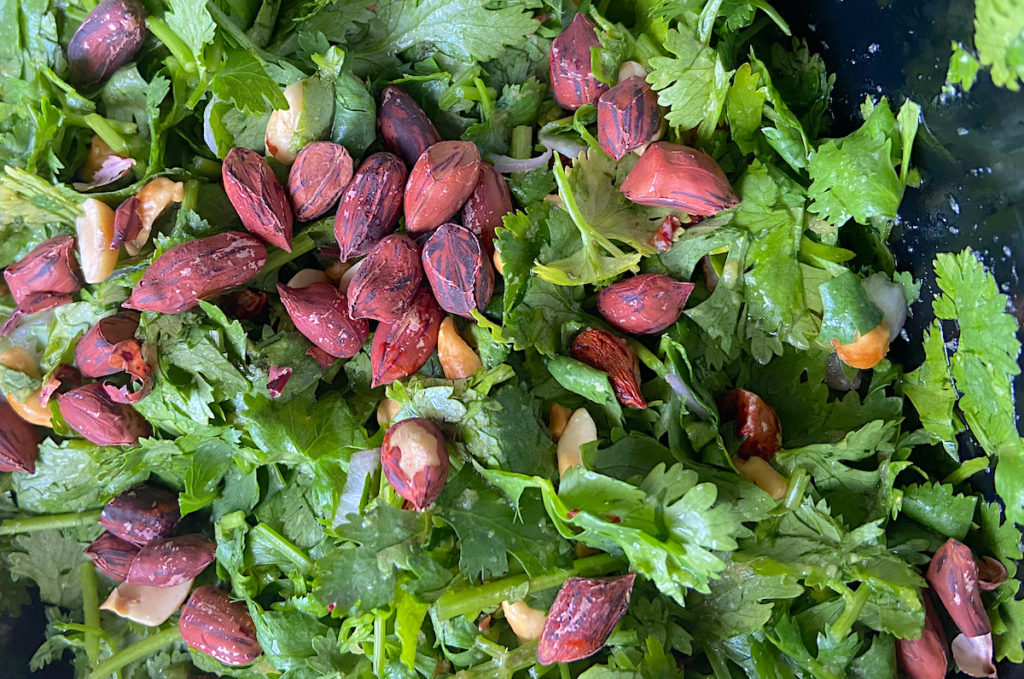Today’s recipe is a simple dish called ‘yum pak chii’ which is made with an abundance of cilantro leaves. While not everyone enjoys the taste of cilantro, also known as coriander, even those who do, may not have considered using the distinctive leaf as a salad green.
This recipe is simple and perfect for gardeners who have an abundance of this herb in their garden. Whether you’re a lover, hater, or somewhere in between, we hope this recipe encourages you to rethink how we can better use the herbs and vegetables we have on hand.

Yum Pak Chii Ingredients
2 cups of picked, washed cilantro/coriander leaves
2 tsp of coconut cider vinegar
3-4 hot Thai chilies chopped (adjust to your preference)
1 tbsp palm sugar
1 tbsp of soy sauce
1-2 tbsp lime juice (about half a lime)
2-3 tbsp of peanuts
Yum Pak Chii Ingredients
- Wash your leaves and chop from the larger stalk. The smaller branches are easy to eat, but you don’t want to include any thicker stalks.
- Set to dry or put in a salad spinner while making your dressing.
- Combine palm sugar, chili, soy sauce, and coconut vinegar in a small bowl.
- Add 1-2 table spoons of lime to taste.
- When ready to serve, pour the dressing over the leaves and mix thoroughly before plating.
- Finish plating by scattering the peanuts over the top and serve.
Is it common to make salad with cilantro in Thailand?
No, although Thais love cilantro it is mostly consumed in curry pastes or as a condiment. There are few dishes where the herb is the main ingredient. This recipe was inspired by experiences eating the salad with hill tribe cooks in Northern Thailand.
Although development has been rapid in the past few decades, the culture and the cuisine of the tribes in the North is often a departure from food around the rest of Thailand. The resulting recipes vary, as do the ingredients from in one village to the next. Don’t be surprised to see some recipes including everything from common Thai ingredients like shallots and tamarind juice, to even spicy red chili paste and crispy pork rinds (as in ยำผักชีแคบหมู).
What can I substitute for peanuts?
We realize so many people around the world have an intense allergy to nuts, especially peanuts. One simple solution to add texture and color, would simple be adding half a cup of halved cherry tomatoes. Some versions of this recipe call for the crispiness to come from pork rinds.
Peanuts are not native to Northern Thailand. In fact, the peanuts pictured with the distinctive ’tiger striped’ skin were introduced by the Royal Project Foundation. The cultivar was successful even in areas of high altitude, which helps local farmers earn income and diversify their crops. Now we’re able to purchase these local organic peanuts from farmers in Chiang Mai and similar provinces.
Are there Thais who think coriander leaf tastes like soap?
They may be out there somewhere, but I haven’t met them. Of course there are people who dislike coriander, but we haven’t met many Thais with as strong disdain as the westerners we encounter. If there’s a community of Thai coriander haters somewhere, please correct me. Also, I have lots of questions for them because the ingredient is extremely common in Thai cuisine, with the seeds, leaves, root/stalk all being consumed.
Is there an alternative to coconut cider vinegar?
You can use similar products such as apple cider vinegar, rice wine, or regular cooking vinegar. You can also use tamarind juice which will add more body to the dressing, or even adjust the recipe by increasing the amount of lime used. Since each ingredient is slightly different be sure to taste and adjust.

